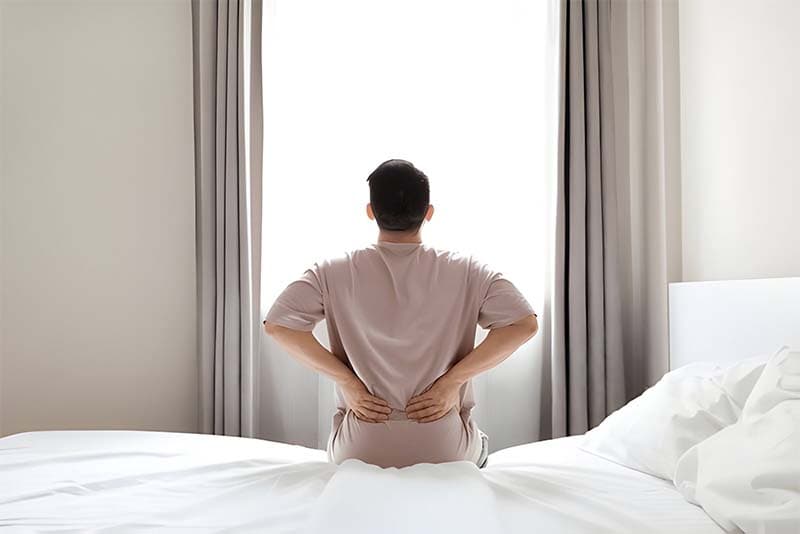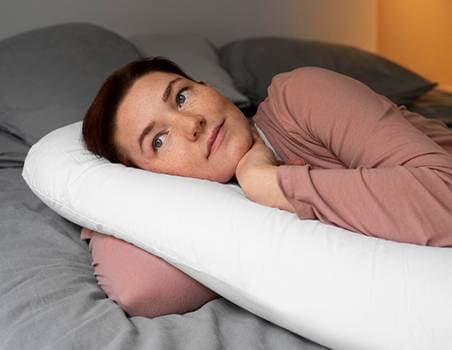Everyone knows good posture is essential. However, good posture is about more than just how we sit and stand. When you sleep, the muscles and ligaments in your back can relax and heal themselves. One way to protect your back is to use good posture while sleeping.
Why is a Good Posture Important?
Good posture is much more than standing tall and proud of how your shoulders affect your health. It is a form of body overuse involving repeatedly bending, straightening, or twisting at awkward angles. It can have long-lasting effects on the spine without exception, even while lying down and sleeping in poor posture in bed.
Good posture influences your ability to stay balanced when you move and walk. This means keeping your weight centered over your feet. Good balance enables you to move more during everyday tasks, like climbing stairs or turning around. Practicing good posture also helps lower your chances of getting hurt while you train or play sports.
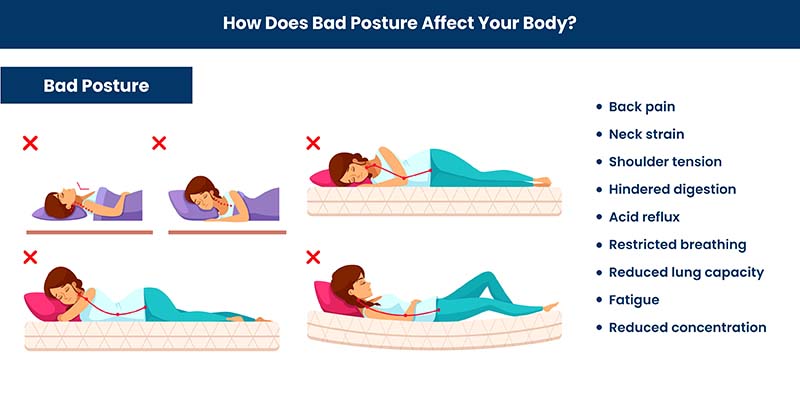
What Can Cause a Bad Posture?
Poor posture can be caused by:
Stress: Stress makes our muscles tight in our neck, back, and shoulder areas. This can result in a curved upper back and poor posture, which puts pressure on our spine. Moreover, stress often leads us to bend over our desks or phones, adding extra strain to our neck and back muscles.
Weak postural muscles: These muscles, including our core, back, and shoulder muscles, play a key role in helping us stand up straight. When these muscles lack strength, it gets more challenging to maintain good posture, leading to slouching and other posture problems.
Inflexible muscles: Tense muscles, such as those in the chest, hips, and hamstrings, can throw our body off balance and result in a hunched posture. Stretching often after sitting for a while is vital to boosting flexibility and stopping muscle imbalances that might cause bad posture.
Pregnancy: When a woman's belly expands during pregnancy, her center of gravity moves forward. This makes her lean back and curve her lower spine to keep steady. Such changes can trigger pregnancy back pain in the lower back and stress the spine.
Obesity: Carrying extra pounds impacts our posture, too. Too much weight strains our muscles and joints, making it more challenging to stand up straight.
Muscles that are too tight: Muscles that are too tight in our legs and feet can also mess with our posture.
Wearing high-heeled shoes: Wearing high heels for a long time can tighten our calf muscles, leading to an odd curve in our lower back.
Best Sleeping Positions for Back Pain
If you have been struggling with backache, paying attention to your sleeping position is crucial. Here are the top five sleeping positions for back pain relief:
1. Lying on your side in a fetal position
The fetal position ranks among the most popular sleeping postures and impacts people with back pain. If you sleep on your side, try curling up like a fetus by pulling your knees to your chest and putting a pillow between your legs. This posture helps to keep your spine neutral, which takes the pressure off your back and lessens pain.
2. Lying on your back in a reclined position
Sleeping on your back also works well to relieve back pain. But you need to make sure your back gets enough support. One way to get a proper back sleeping position is to use a bed that reclines or a mattress you can adjust. These beds let you change the position of your upper body, which keeps your back comfortable and supported.
3. Lying on your side with a pillow supporting your knees
If you like to sleep on your side, keep your spine straight. You can do this by putting a pillow between your knees. This keeps your hips, pelvis, and spine in a good position. It also helps to lower stress in your back muscles and ease pain.
4. Lying on your stomach with a pillow below your pelvis and lower abdomen
Sleeping on your stomach isn't a good idea if you have back pain. It can strain your neck, shoulders, and lower back. But if you can't sleep any other way, try putting a pillow under your pelvis and lower belly. This helps keep your spine straight and removes pressure from your back muscles.
5. Lying flat on your back with a pillow underneath your knees
Another way to sleep that's good for your back is to lie on your back with a pillow under your knees. This keeps the natural curve of your spine and reduces the pressure on your back. Also, putting a pillow under your knees can help ease pain for people with sciatica.
Worst Sleeping Positions for Back Pain
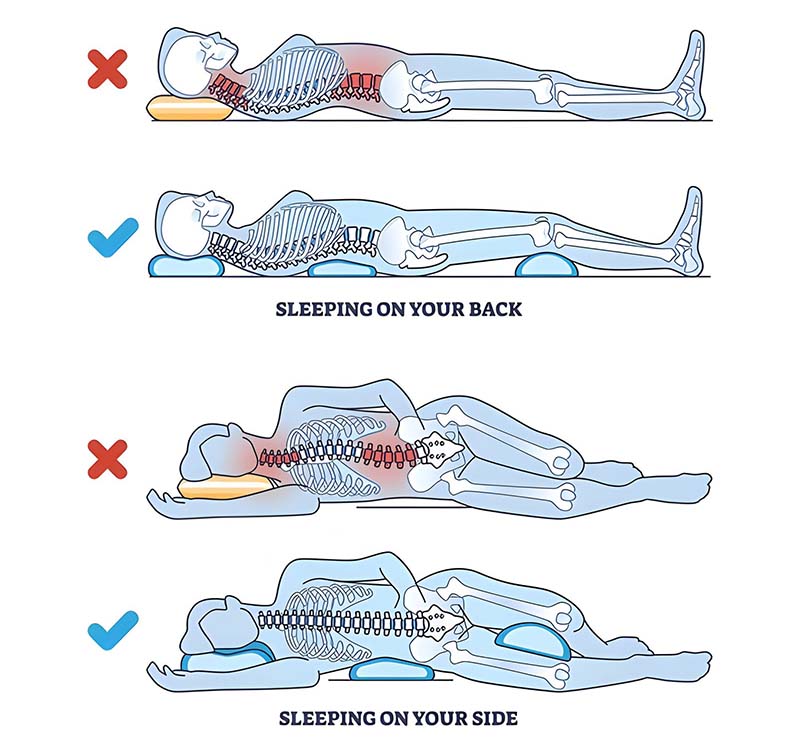
There are a few sleeping postures that can create excess pressure on your back and elevate your pain:
Lying on your Stomach
Sleeping on your stomach can pressure your neck and shoulders because you turn your head at an odd angle. Over time, stomach sleeping position may also cause strain to your spine. If your back hurts, you should teach yourself to sleep on your side instead of your stomach.
Lying on Your Side Twisted
Sleeping on your side in the fetal position supports your back, but twisting while on your side can twist your spine when your top leg crosses over the bottom one. Putting a pillow between your knees helps reduce the twisting and supports your lower back.
How Does a Pillow Help You Keep a Good Posture?
A pillow plays a crucial role in keeping your posture sound by helping to align your spine in your neck and upper back areas. Here's how it helps:
Supporting Natural Spinal Curvature: A quality pillow bridges the space between your head and mattress, supporting the natural shape of your neck and spine. Such alignment prevents your spine from bending or extending too much, which can cause discomfort and pain.
Reducing Muscle Strain: The proper pillow support lowers the strain on neck muscles and ligaments. When your head has adequate support, muscles can relax. This allows for better blood flow and reduces the risk of stiffness or tension.
Preventing Poor Posture Habits: A pillow that fits your sleeping position (back, side, or stomach) helps keep your spine neutral. This stops lousy posture habits from forming, which can lead to long-term spine problems.
Enhancing Sleep Quality: A pillow with comfortable support lets you sleep deeper and wake up feeling better. A good pillow can help you avoid waking up stiff and sore by making you more comfortable and relaxed.
Choosing the Right Pillow: Different types of pillows (like memory foam, latex, or down) provide different levels of support and comfort. To get the best spine alignment and sleep quality, it's key to pick a pillow that matches how you sleep and what you like.
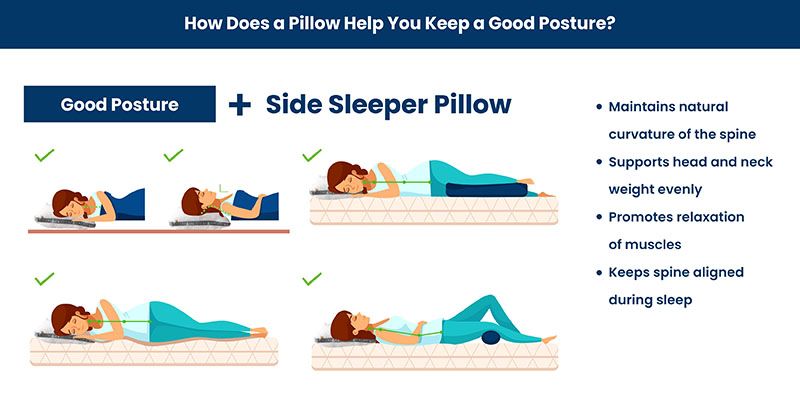
Tips to Sleep Better and Prevent Back Problems
Here are some ways to sleep better and avoid back issues:
- Supportive Sleep Surface: Pick a mattress and pillows that give your body enough support for your spine. The right firmness and support can help keep your body in line and reduce sore spots.
- Sleeping Position: Choose a side sleeper position to keep your spine straight. Sleeping on your back with a pillow between your knees is also effective. Avoid sleeping on your stomach as it can hurt your neck and lower back.
- Good Sleep Habits: Start a regular sleep schedule by going to bed and getting up at the same time each day. Make a relaxing bedtime routine to tell your body it's time to slow down.
- Manage Stress: Try relaxation methods like deep breaths, quiet reflection, or easy stretches before bed to lower stress and help you unwind.
- Exercise: Regularly work out to build your core muscles and support your spine. But don't do hard exercise right before bed, as it might interfere with your sleep.
- Create a Sleep-Friendly Environment: Make your bedroom cool, quiet, and dark to help you sleep well. Consider using earplugs, dark curtains, or white noise machines if you need them.
- Monitor Your Posture: When you sit or stand all day, pay attention to how you sit or stand when you're in one position for a long time. Use chairs and desks that fit your body well, and take breaks to stretch and move around.
- Cut Back on Coffee and Booze: Don't drink coffee or alcohol right before bed. They can mess with how well you sleep and throw off your body's natural sleep patterns.
- Good Pillow: Since side sleeping is recommended as the best position for reducing stress from your back then a side sleeper pillow is something you should consider. A side sleeper pillow will let you maintain a proper spinal posture throughout the night. It will cradle your neck and support your shoulders to align your head, neck, spine, and shoulder.
Final Thoughts
Good sleeping posture plays a great role in keeping your spine healthy and helping you sleep well. Pick a pillow and mattress that fit how you like to sleep. This can lower your chances of back issues. Whether you sleep on your back, side, or stomach, keeping your spine straight helps avoid sore muscles and pain.
It's also vital to have good sleep habits. Try to go to bed and wake up simultaneously each day. Find ways to deal with stress. Make your bedroom a good place to sleep. Working out often to build your core muscles and standing up straight during the day helps keep your spine in good shape.
Focusing on how you sleep and getting the proper support can boost your sleep quality and overall health. Remember that a minor change in your bedroom setup and routines can significantly impact avoiding back pain and helping you sleep better.

